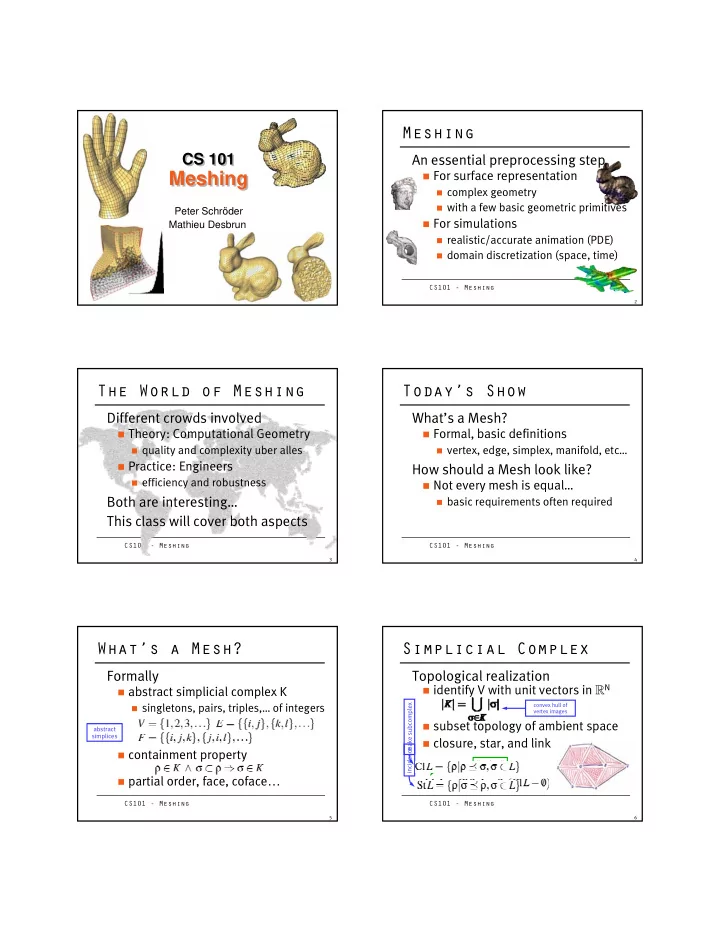

Meshing CS 101 An essential preprocessing step CS 101 Meshing � For surface representation Meshing � complex geometry � with a few basic geometric primitives Peter Schröder � For simulations Mathieu Desbrun � realistic/accurate animation (PDE) � domain discretization (space, time) CS101 - Meshing 2 The World of Meshing Today’s Show Different crowds involved What’s a Mesh? � Theory: Computational Geometry � Formal, basic definitions � quality and complexity uber alles � vertex, edge, simplex, manifold, etc… � Practice: Engineers How should a Mesh look like? � efficiency and robustness � Not every mesh is equal… Both are interesting… � basic requirements often required This class will cover both aspects CS101 - Meshing CS101 - Meshing 3 4 What’s a Mesh? Simplicial Complex Formally Topological realization � identify V with unit vectors in R N � abstract simplicial complex K make subcomplex � singletons, pairs, triples,… of integers convex hull of vertex images � subset topology of ambient space abstract simplices � closure, star, and link incidence � containment property “1-ring” � partial order, face, coface … CS101 - Meshing CS101 - Meshing 5 6
Topological Structure Topological Invariants 2-manifold (with boundary) Euler characteristic � for surfaces: F-E+V= χ =2(1-g) � every point has an open, (half-) disklike subset surrounding it � not required to be simplicial � more generally for simplicial complexes � |K| 2-manifold iff |St v| ~ R 2 � proof by induction (shelling) � relation to Hopf index theorem CS101 - Meshing CS101 - Meshing 7 8 Simplicial Complex Other Views Geometric realization Topological realization � the concrete embedding π v (|K|) � mesh in space given by PL basis functions with vertices as coefficients � piecewise linear Not mentioned � vertex images specify everything � we may allow self intersections � cell complexes—but rather obvious � derivative map injective (typically) � quad meshes quite useful � immersion CS101 - Meshing CS101 - Meshing 9 10 What is Meshing? Brief Glossary General Idea: “flat” 2D “flat” 3D Node, element: � breaking up a physical domain Structured/Unstructured Mesh: � 2d domain in 2d, or in 3d, or 3d domain � regular valence and degree � into simpler subdomains— elements Isotropic/Anisotropic Mesh: � simplices or not (triangle, quads, …) � without/with stretched elements Graded Mesh: � w/ elements varying in size CS101 - Meshing CS101 - Meshing 11 12
Brief Glossary Why (Un)Structured? Structure brings: Node, element: � simpler data Structured/Unstructured Mesh: structure � regular valence and degree � better Isotropic/Anisotropic Mesh: compression � without/with stretched elements � reuse of DSP algos � smoothing Graded Mesh: � wavelets Unstructured Unstructured � w/ elements varying in size meshing meshing Structured Structured meshing meshing CS101 - Meshing CS101 - Meshing 13 14 Brief Glossary Why Anisotropy? Node, element: Structured/Unstructured Mesh: � regular valence and degree Isotropic/Anisotropic Mesh: � without/with stretched elements Graded Mesh: # V # V # F # F Isotropic Isotropic # V # V # F # F � w/ elements varying in size meshing meshing # V # V # F # F Anisotropic Anisotropic meshing meshing Anisotropic Anisotropic quad meshing meshing quad CS101 - Meshing CS101 - Meshing 15 16 Brief Glossary Why Gradation? Node, element: Allows Structured/Unstructured Mesh: for better � regular valence and degree capture of details for same Isotropic/Anisotropic Mesh: vertex � without/with stretched elements budget Graded Mesh: � w/ elements varying in size CS101 - Meshing CS101 - Meshing 17 18
Future Lectures Some themes will review: � Delaunay/Voronoi � inside out! Very cool theory, very useful in practice too. � Resampling � simplification, mesh improvement, … � Reconstruction � where do meshes come from?? CS101 - Meshing 19
Recommend
More recommend